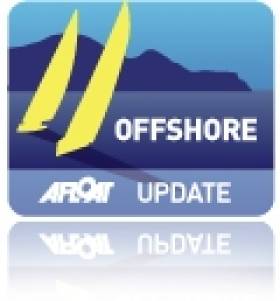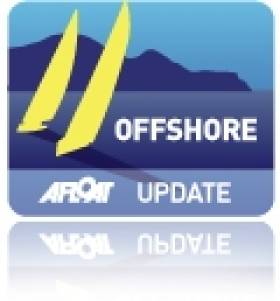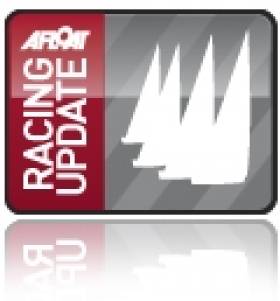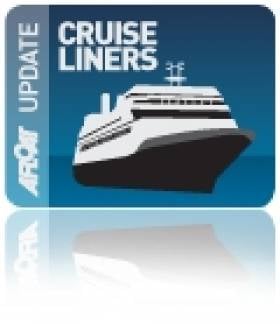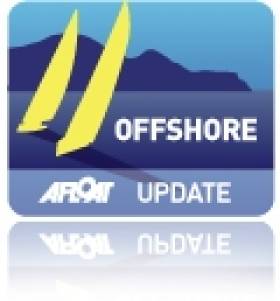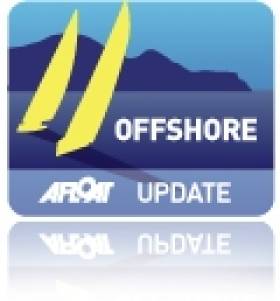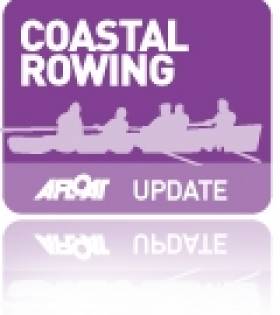Displaying items by tag: Transatlantic
Puma Finishes Transatlantic Race
"We entered the race with zero expectations, just like the other IRC handicap racing we've done this year," Read said. "We wanted to learn the boat and the crew. Now, here we are in the position of possibly winning a race that we didn't expect to win. We're pleasantly shocked. We didn't break anything, the sails held up, the team is certainly coming together, and there's not a single negative to this race. It was a great experience."
The race was the first test for the PUMA team and new Volvo Open 70 racing yacht. The 11-member crew departed Newport, R.I., on Sunday, July 3, alongside five other boats in IRC Class 1 in the final start of the race. Rambler 100 (skipper George David) earned line honors after finishing on Sunday, July 10, at 16:08 UTC. Also in the class: ICAP Leopard (Clarke Murphy); Beau Geste (Karl Kwok); Sojana (Peter Harrison); and Vanquish (USMMA – All American Offshore Team). Overall, 26 boats ranging from 40 to 289 feet in length entered the race.
PUMA's Mar Mostro reached a maximum speed of just over 30 knots early in the race, traveling 551 nautical miles on Day 3. By Friday, light air slowed the pace through the line.
"The finish was excruciating," Read said. "We approached The Lizard, knowing we had to get there quick because the current was about to change and go against us. As we entered the English Channel, the breeze was dying steadily to the point where the current did change. Literally, when the race committee said we were finished, we were stopped and about to throw the anchor as we would have been going backwards with the current. A bizarre twist to the finish.
"But, this is boat racing," Read continued. "It's great training because you have to be ready for the extreme highs and lows, and that goes for weather as well. To finish in a complete drift off is another lesson learned – be prepared for everything."
Read and crew are not stopping in the U.K., but are already heading south to the Canary Islands. The team's summer training headquarters becomes the Puerto Calero Marina in Lanzarote at the end of this week. From there, the crew will head to the race start location of Alicante, Spain, in late September. Next racing on the docket is the Volvo Ocean Race with Leg 1 beginning November 5.
"The boat doesn't have a list of any real problems," Read said looking ahead. "But, we can't sit back and think 'we're done,' or that we're great. We know we have to get better, and an experience like this helps us sort out a lot of little things that we can get better at. If you don't improve every day, then you're going backwards because everybody else is improving."
Transatlantic Race 2011 Nears Finish
Newport, R.I. USA (July 9, 2011) – For the last 24-hours of the Transatlantic Race 2011, light air has persisted for virtually the entire fleet -- frustrating the progress of nearly every boat. Small gains in these conditions can be turned into massive advantages as finding breeze under a patch of cloud or during a rainsquall can deliver huge percentage gains and those few precious miles can mean getting into new breeze, hopefully hours before the opposition.
All of the yachts in the Transatlantic Race 2011 have access to detailed weather forecasts, and global weather models like NOAA's GFS (National Oceanic and Atmospheric Administration's Global Forecast System) are great tools for understanding the broad weather pattern. They run, however, at a resolution of 60km and are unlikely to pick up the local effects out in the Atlantic, especially as the fleet encounters land-produced effects. Weather forecasting may have been around for over 100 years, but a sailor's experience is often more reliable than any computer models. A well-known yachting term, 'head out of the boat' is a very poignant factor right now. Finding breeze in these fickle conditions is golden.
Rambler 100, skippered by George David (Hartford, Conn.), looks to be the odds-on favorite for line honors and is expected to cross the finish line at The Lizard, on the south coast of England, around mid-day Sunday, July 10. PUMA Mar Mostro, skippered by Ken Read (Newport, R.I.) has taken a two percent time penalty allowing them to stack sails and is still currently leading IRC Class One on corrected time -- although not the race overall.
Carina, the McCurdy and Rhodes 48 skippered by Rive Potts, Jr. (Essex, Conn.) which started the race on June 26 has that honor (current overall race leader). There will probably be a national holiday in the yacht's hometown if they pull off a win against such esteemed opposition. Unfortunately, Carina was barely making any headway today and still has well over 700 miles to go. Potts and his crew will be praying for more wind and the team will be doing everything they can to find it. While looking to have a win in IRC Class Four sewn up, Carina only needs to average about five and a half knots to see them seriously challenge for the overall title.
In IRC Class Two, Jazz navigator Mike Broughton (Hamble, U.K.) reported via satellite phone this morning to say that they had found a fairly consistent breeze from the northwest and were making good headway. Jazz is a firm favorite for taking class honors and still has an outside chance of taking an overall victory after time correction.
"The boat is immaculately clean, something that the crew all pride themselves in," said Broughton confirming that – apart from the diet -- all is well onboard. "This morning we are enjoying some freeze-dried granola for breakfast, which is definitely our favorite energizer in the mornings. However, every other day we have freeze-dried scrambled egg and I have to say that once we get ashore, I will be happy not to see that particular delicacy for a very long time."
In IRC Cass Three, Zaraffa, the Reichel Pugh 65 skippered by Huntington Sheldon (Shelburne, Vt.), has just over 500 miles to go, along with a virtually unassailable lead in its class. And in the Open Class, Phaedo, skippered by Lloyd Thornburg (St. Barths), has understandably enjoyed the lighter breeze, far more than its heavy weight opponent Maltese Falcon. The Lamborghini orange Gunboat 66 has skipped away some 40 miles ahead of the Perini Navi.
While the end of the race is approaching for the front runners, spare a thought for Mike Hennessey (Mystic, Conn.) and Rob Windsor (East Northport, N.Y.), who are sailing the Class 40 Dragon double-handed and who updated their progress by satellite link.
"In the past 24 hours we have achieved three milestones: We reached the most remote point we will get to in this race: 825 miles to Cape Spear, Newfoundland, to the west and 825 miles to Great Skellig Island, Ireland, to the east and 700 miles to Kap Farvel, Greenland to the north. I have no idea if any of those places even have a port we could get into, but it's nice to know where you would have to bail out to!
"We passed the 1000-mile mark, with 980 some odd miles to go to the finish. We have had our first upwind work of the entire race. Currently slapping our way through short chop on our way east, under gray and cold skies."
Sponsors of the TR 2011 are Rolex, Thomson Reuters, Newport Shipyard, Perini Navi and Peters & May, with additional support by apparel sponsor Atlantis Weathergear.
Transatlantic Race 2011 and Small Cat v Mega Yacht (Video!)
Like any good sailing match race, the second class to depart in the Transatlantic Race 2011 today was a duel of two radicals – this time between a 66ft carbon cat, and a 289ft 3 masted mega yacht. Today size didn't matter and the nimble cat, the Gunboat 66 Phaedo, quickly shot away leaving the Perini Navi, Maltese Falcon, flapping in her tracks.
A floating crane-barge with a 1,000 ton lifting capacity hoisted the structure sky-high away from the ship which was berthed at the Grand Bahama Shipyard drydock facility. The ships owners, Princess Cruises cited the main reason for the removal was in order to 'significantly improve the operational performance of the ship, including greater fuel efficiency.'
Grand Princess may have lost her signature Skywalker Nightckub but three-decks below a new nightclub, One5, inspired by its Deck 15 location was created. In addition to this work which took place during April and May the 2,600 passenger cruisehip also underwent a major refit. The ship which had its last major refurbishment in 2004 has amenities to include an outdoor movie screen, fitness centre, spa, casino and four swimming pools.
For 'interactive' deckplans click here and interior slideshow click this link.
The distinctive 'Skywalker' feature became one of the most iconic in cruiseship naval architecture when the Grand Princess was launched as leadship
of the 'Grand' class in 1998. Located at the extreme aft of the vessel, the nightclub could only be reached by clubbers using an angled walkway (photo). Externally the feature was referred by some as the 'shopping trolley' and others percieved the design infleunce from towering poops found on ancient war-faring galleons.
Irrespective of the design origins, another 10 'Grand' class vessels were built by the Italian Fincantieni (at Malfalcone) Shipbuilding Group. The 'handle' (photo) feature on the Grand Princess was made with a heavier material compared to Golden Princess (2001) and Star Princess completed a year later. So there are no plans to remove these nightclubs. Of the more recent additions to the class modifications have appeared, notably without the inclusion of the Skywalker Nightclub's but there are changes to funnel designs.
Outside the Princess Cruises brand, the Ventura and Azura (also of the Grand-class) operate for P&O Cruises, serving the UK market from Southampton. The Hamsphire port welcomed the pioneering leadship Grand Princess on 5 May after she made a 16-day trans-Atlantic repositioning voyage from Port Everglades.
The cruiseship which has a crew of 1,200 alone will make the UK port its seasonal homeport this year from where she sails on cruises in Europe. On one of these cruises itineraries the Grand Princess (290m long x 36 beam X 8.5m draft) included a visit to the Port of Cork today. You can monitor the ship from Cobh Cruise Terminal via the 'live' bridge web-cam, noting the vessel is due to depart at 18.00 this evening bound for Dublin Port.
Grand Princess became the first cruiseship to measure over 100,000 gross registered tonnes when the 108,806 (grt) vessel docked in Dublin on 31 August 2004.
Last year the port handled 88 cruisecalls and this number of vessels is to be closely repeated this season. Over 200 cruise calls with around half a million passengers and crew are scheduled to visit the island of Ireland. The cruise sector business is estimated to generate €60m to the economies
north and south.
Two Irish Boats for Transatlantic Race 2011
Two big names in Irish offshore racing are among the 30-boat fleet preparing for the Transatlantic Race 2011 (TR 2011) this June. Last night the organisers, the Royal Yacht Squadron, New York Yacht Club, Royal Ocean Racing Club and Storm Trysail Club, extended the deadline to enter the Race to March 31, 2011.
Adrian Lee's Cookson 50 from Dublin Bay and the Limerick Volvo 70 skippered by Ger O' Rourke's both make the entry list although the Shannon estuary's Chieftain is described only as a 'provisional' entry. For Entry list click HERE.
With the Transatlantic fleet now over 30 entries and many new inquiries following the success of the RORC Caribbean 600 - part of the companion Atlantic Ocean Racing Series - the organisers encourage those interested to enter the TR 2011 as soon as possible to secure a spot since the Notice of Race notes a maximum of 50 yachts for the race.
The TR 2011 will cover 2,975 miles from Newport, R.I., to the Lizard in England. The focus of pre-race activities will be the New York Yacht Club's Harbour Court clubhouse in Newport, R.I. There will be three staggered starts from June 26 to July 3. The awards ceremony on August 9th and other post-race activities will be held at the Castle, the home of the Royal Yacht Squadron in Cowes, England.
The fleet will include IRC Racing, IRC Racer/Cruiser, Classic and Open divisions with a minimum length overall (LOA) of 40 feet and no maximum. Competition is building within several segments of the diverse fleet, notably the 100' and up range which includes Sojana, Rambler 100, ICAP Leopard, and Maltese Falcon.
Tight racing is also expected in other classes and divisions, such as yachts in the under 50' range in IRC Racing and IRC Racer/Cruiser including the Class 40s - Concise 2, Dragon, and Kamoa'e, the Rogers 46s - Shakti and Varuna, as well as British Soldier ASA, Jacqueline IV, Sasha, Dawn Star, and Carina. For a complete list of entries click here.
All race documents are available HERE.
The TR 2011 is the centerpiece of the Atlantic Ocean Racing Series (AORS), and is organized in concert with the following clubs: Royal Malta Yacht Club, Annapolis Yacht Club, Ida Lewis Yacht Club, Montego Bay Yacht Club, Naval Academy Sailing Squadron, Jamaica Yachting Association, Antigua Yacht Club and Real Club Nautico de Sanxenxo.
Two races in the AORS have been completed: the Pineapple Cup - Montego Bay Race and the RORC Caribbean 600. The Pineapple Cup, from Ft. Lauderdale, Fla. to Montego Bay, Jamaica, a distance of 811 miles, was won by Genuine Risk, a 97-foot canting keel super maxi skippered by Hugo Stenbeck. In the RORC Caribbean 600, George David's Rambler 100, took line and overall IRC honors and set the monohull record of one day, 16 hours, 20 minutes and 2 seconds for the course's 600 miles.
Irish Sea Robotic Yacht Disappears
Galway's Atlantic Oarsman in World Record
At the beginning of August, a 23ft four-man rowing boat arrived off The Lizard, England's most southerly headland and the traditional point for Transatlantic bids, to establish a new transoceanic rowing time for the crew of one Irishman, two Scotsmen, and a Faroes islander. Lorna Siggins of The Irish Times set the scene as they made their first landfall approaching the Isles of Scilly fifty miles westward. Click HERE.
Click this link for Irish Rowing detailsClick this link for the Latest Rowing News
No Transatlantic Record for Leopard
ICAP Leopard, the 100ft super-maxi racing yacht owned by Helical Bar PLC chief executive Mike Slade, has ended her transatlantic record attempt. After a fantastic start, ICAP Leopard found herself in a windless high pressure at 02:00 UTC on Saturday 420 nm from the finish. With the record looking less and less achievable, Skipper and Boat Captain Chris Sherlock took the decision to abandon the attempt.
Having started on Saturday 29th May in New York, ICAP Leopard has had to contend with variable conditions from the start. The crew worked hard in the first few hours to position themselves correctly to pick up a weather front with enough breeze to get them up to record speed. Having achieved this, the crew were then able to keep the boat going fast through a cold and wet few days mid-Atlantic. With a record attempt of this nature the weather has to be consistently good for the entire voyage, which is hard to predict 9 or 10 days in advance. On this occasion a high pressure system on the approach to the UK blocked ICAP Leopard’s path and ended any hope of breaking the record.
ICAP Leopard Owner, Mike Slade, commented: ”We have a great yacht which has now proven itself over the last three years to be physically fast enough and powerful enough to easily churn out 500+ miles day after day and could have broken this record. However, on this occasion it materialised that the weather was not on our side and after a fantastic run at the start, the crew were forced to gybe all the way home during the latter part of the race. It just goes to prove how difficult this record is to beat and what a great boat Mari Cha IV was.”
Chris Sherlock also commented: “The crew did a phenomenal job to put us in such a great position during the first 5 days of the attempt, it is just a real shame that the forecast didn’t work out for us on this occasion. When we started we always knew that there may be a ridge of high pressure blocking our route to the finish, but we hoped that we would be able to navigate our way through without slowing too much. It is really disappointing that our record attempt was thwarted by the wind gods but no doubt we’ll be back to take on the mighty Atlantic again next year.”
ICAP Leopard was the most high-profile racing yacht to take part in the last Round Ireland, but this time around she will compete in the JP Morgan Round the Island Race on 19th June followed by a large number of corporate charters and sponsor commitments in the UK. Her next record breaking adventure will see Slade and his crew attempt to take on the Sevenstar Round Great Britain & Ireland Race starting on August 23rd this year.
Once again they will be equipped with a tracker and their adventures can be followed at www.leopard3.com. Following this ICAP Leopard will head to the warmer waters of the Mediterranean and the Caribbean for further racing on the International circuit.
ICAP Leopard Begins Transatlantic Record Attempt
Round Ireland race record holder ICAP Leopard, the 100ft super-maxi racing yacht owned by Mike Slade, crossed the start line at Ambrose Light on Saturday to begin her attempt on the 2,925 nautical mile monohull transatlantic speed record. ICAP Leopard will need to cross the finish line at Lizard Point before 12h 37m UTC on Saturday 5th June to break the current record held by Mari Cha IV of 6 days, 17 hours and 52 minutes.
Starting in 15 knots of wind, ICAP Leopard will head north to hook into a weather system developing over Nova Scotia this weekend. It is hoped that ICAP Leopard will be able to ride this weather system all the way across, however she may encounter some high pressure on the approach to the UK. It is hoped a fast start will give ICAP Leopard a good chance of getting through the high pressure and across the line in record time.
ICAP Leopard will be carrying a GPS tracker during her record attempt, to follow her progress online go to: www.leopard3.com
ICAP Leopard, the 100ft super-maxi racing yacht owned by Helical Bar PLC chief executive Mike Slade, is this week berthed in New York’s bustling financial district as she prepares to launch her assault upon the west-to-east monohull transatlantic sailing record in the coming weeks. Irish fans will remember this yacht holds the Round Ireland record after a spectacular circuit of Ireland in 2008.
Since her launch in 2007 ICAP Leopard has broken 12 major offshore racing records, including the fastest elapsed time ever set in the prestigious Rolex Fastnet Race. This voyage will see her tackle the well-trodden path between Ambrose Light, NY and the Lizard Point, which marks the entrance to the English Channel. Her target for this attempt will primarily be the record for monohull yachts with power-assisted systems of seven days, 19 hours and 21 minutes that she set in June 2008. However, since setting this benchmark the yacht has undergone a series of modifications and the crew are confident that, given the right conditions, Mari Cha IV’s outright monohull transatlantic speed record of 6 days 17 hours and 52 minutes will be achievable.
As with all major sailing record attempts, negotiating complex weather systems will play an integral role in ICAP Leopard’s latest transatlantic foray. The man responsible for the successful handling of the meteorological situation onboard will be veteran navigator Hugh Agnew.
Chris Sherlock, ICAP Leopard’s boat Captain commented: “We can’t wait to get stuck into another attempt on the Atlantic record. Last time a tight weather window forced us into accepting less than ideal conditions for our record run but we have slightly more leeway this time. Our weather window will open on the 11th May and then we will have roughly three weeks to plan our departure. This should allow us to set ourselves up for the best possible weather pattern.”
Owner Mike Slade commented: “This is something that I have been looking forward to ever since we crossed the finish line last time around. It has been brilliant to hold the record for yachts with power-assisted winches but we know we can go faster. The yacht and crew have been tempered over a two year period of hard racing and we are now sailing faster and harder than ever before. We will have a decent period of time in which to pick our weather window and the crew are all preparing to go on standby for what promises to be a thrilling sprint across the pond!”
ICAP Leopard will be carrying a GPS tracker that will allow spectators to follow her progress online at www.leopard3.com




























